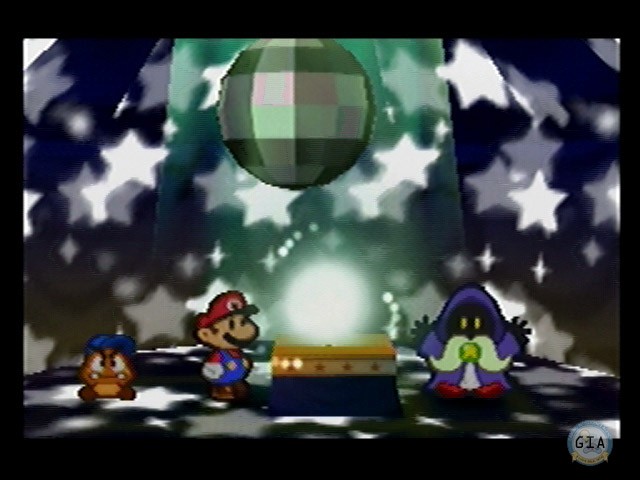
 |
|
Super Mario RPG was not only one of the great RPGs for the Super Nintendo, but quite possibly the farthest Nintendo has ever trusted their flagship characters to a third party. Unfortunately, in the five years since the game was released, Nintendo's relationship with Square has dwindled to nothing, and the pseudo-sequel was to be made by a new developer.
Many assumed this would mean an automatic drop in quality, but the new developer was one of the few in the world with a portfolio that dwarfs even Square's: Donkey Kong, Mario Bros., Duck Hunt, Excitebike, Metroid, Kid Icarus, Super Mario Land, Tetris Attack, and the seminal Super Metroid. Known first as simply R&D1 and now as Intelligent Systems, this in-house division of Nintendo also handles their most popular RPG series, Fire Emblem. Viewed within this outstanding pedigree, the high quality of Paper Mario comes as much less of a surprise. The innovative graphics and battle engine more than compensate for a rescue-the-princess story, and the complete lack of any loading time and resulting fluidity will take even RPG veterans by surprise.
The game uses a system of 2D sprites moving in 3D environments to maximum effect, having the paper-thin characters (hence the title) float and slide their way through brightly colored settings. Mario doesn't climb into bed, but jumps and floats underneath the sheets, and entire buildings fold their way open and closed. Text doesn't simply scroll, it waves, zooms, and rattles into view depending on the drama of the situation. And while the camera isn't manually controllable, the pre-set angles give a good view of the action without obscuring enemies or items. Exploration takes place throughout the 3D environments that have visible enemies; touching an enemy leads to battle on a 2D plane. First strike is gained by jumping on an enemy or hitting it with your hammer, while the enemy can do likewise by surprising Mario in a variety of ways. Once in battle, you can choose from various jump or hammer attacks, use a special attack, or switch to Mario's partner.
The partner system is the most unique aspect of the battle engine, as various helpers will join Mario during his adventure and provide help in and out of battles. From a young goomba who provides details about an enemy to a friendly paratroopa that carries you over gaps, exploiting these helpers is key to survival. Both Mario's and his helpers' abilities can be augmented through the use of badges. The badges are a variant of the ability system found in Final Fantasy IX, but with greater balance and much added flexibility. Badges can be won, bought, or found and will grant the party new attacks, better stats, or a variety of other beneficial effects. The number of badges is limited by the Badge Points (BP) you have, which can be raised at level up along with Heart Points (HP) and Flower Points (FP). Most attacks beyond basic physical hits use FP, and only one of the three can be raised for each level gained.
Customization possibilities here are varied and useful, unlike the filler choices provided outside a few powerful attacks as in most RPGs. If you prefer jumping on enemies, then you can choose between badges that allow you to jump continuously, jump from enemy to enemy, jump with extra power, jump to add status effects, and more. The gameplay is also made easier by responsive controls and zero loading time. The first time you hit a save block and watch the game save almost instantaneously, you will be amazed. You'll probably save again just to enjoy the lack of little bars that crawl slowly across your screen. Whether between rooms in a building or entire areas, the game flies along at a fast clip that is made even faster by the ability to avoid fights if you so choose. Stylistically, the game is pure Mario. There are goombas and koopas, mushrooms and fire flowers, all connected by pipes that warp. The story is stock rescue fare, with Bowser using his theft of the Star Rod to kidnap Princess Peach and her entire castle. What makes the story compelling anyway is the fantastic translation – “They better call the sequel Paper Bowser!” – and the dozens of nuances which pass in the time in an entertaining way.
Extra items and mini-quests abound, always seamlessly integrated into the world rather than feeling tacked on like a random card game. It's easy to spend hours playing Jump Attack at the local casino or doing favors for the senile Koopa Koot, and should you lose track of the storyline, a fortune-teller is waiting to help. There's even a touch of Metal Gear Solid thrown in as Princess Peach sneaks around her castle trying to get information for Mario. In a way, Paper Mario is what you'd expect in how it stays true to the characters and settings of the Mushroom Kingdom. But even old standbys are presented here with fresh faces, and the gameplay combines platform timing and role-playing depth effortlessly into a largely new experience. It's the old Mario charm wrapped around novel ideas, and should be easily enjoyed by fans of either. Review by Ed McGlothlin, GIA. |
|
|||||||||||||||||||||||||||||||||||||||||||||||||||






